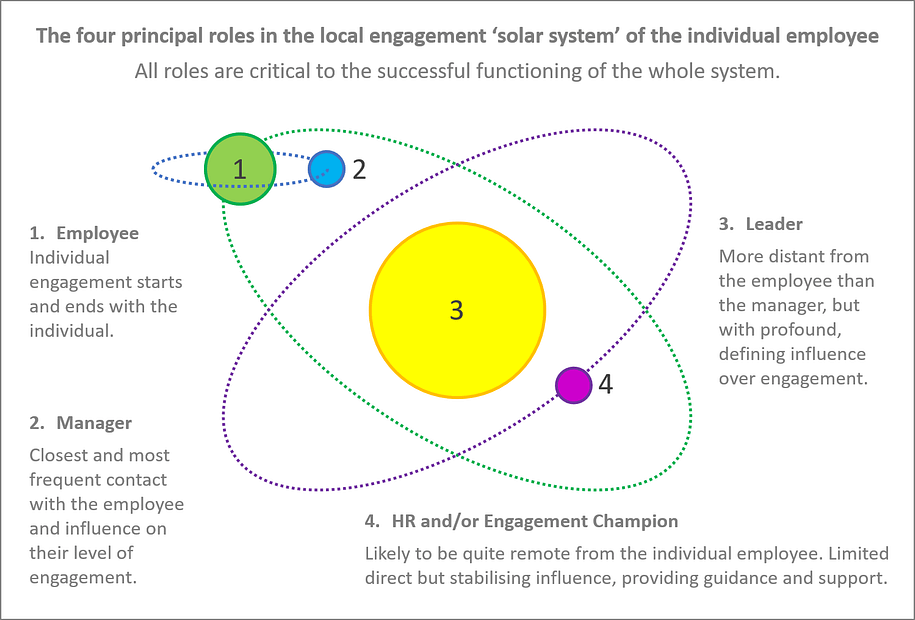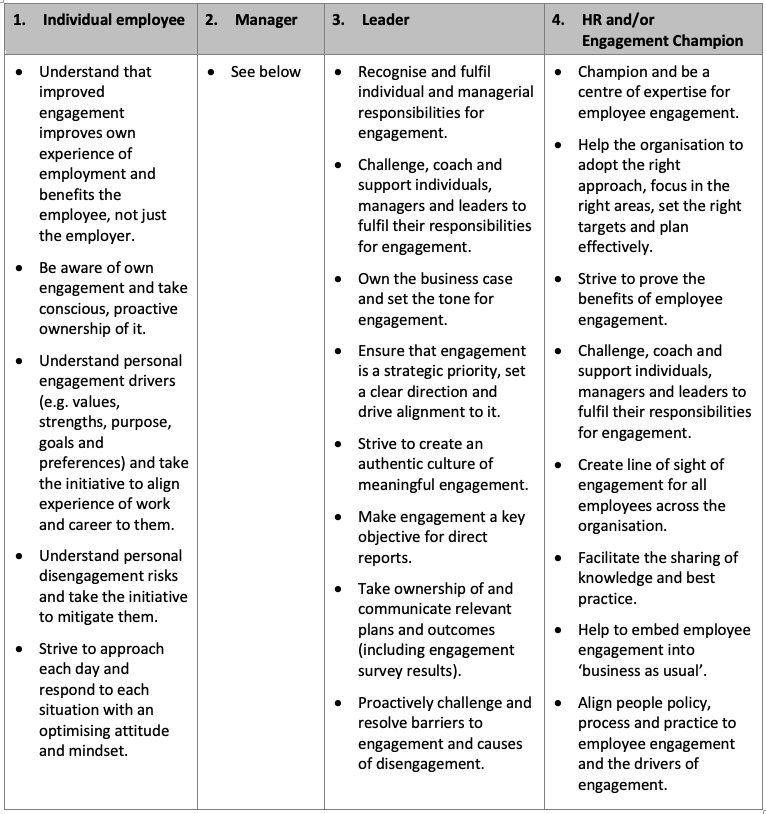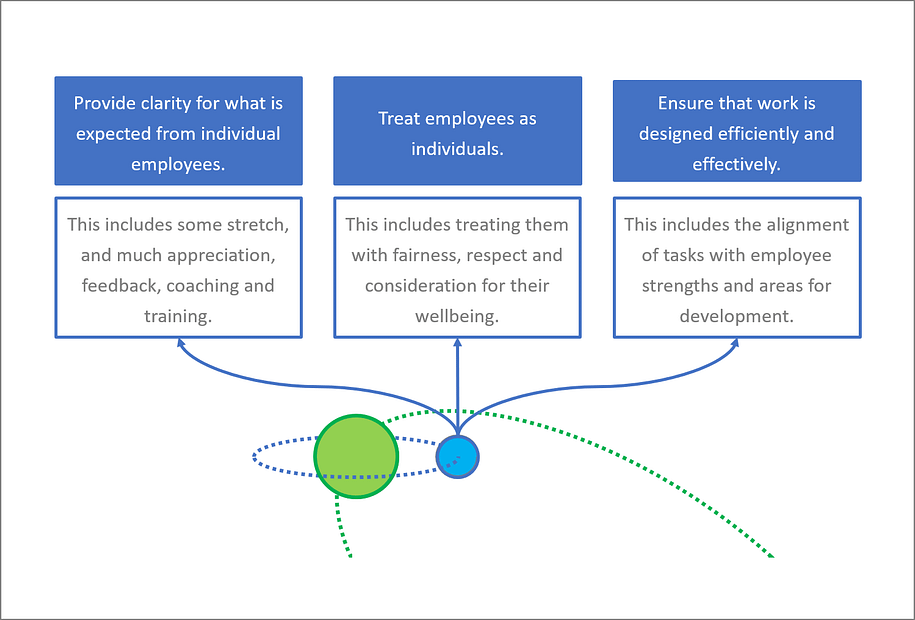
PART 2 - THE ROLE OF THE ENGAGING MANAGER
Introduction: Part of the Problem or Part of the Solution?
Managers are the problem – that’s how it can feel sometimes. After all, “people leave managers, not companies,” right?
The general sentiment shared by many academics, employers, consultants, third party solution providers and, of course, employees themselves, implies that responsibility for the employee experience – and employee perceptions of it – sits almost entirely on the shoulders of managers.
Here at the Engaging Managers’ Zone, we know better. We’ve seen a room full of experts spend all day in front of a flip chart before concluding that the answer is ‘managers’; and then they put down their pens, as if that’s the problem solved.
It doesn’t help anyone. It doesn’t help you. Especially when you don’t then get the support you really need to make a difference.
Before we get into what we think and how we want to help you, let’s take a quick look at…
What 'they' say
In recent years, there’s been an explosion in the exploration of links between employee engagement, management practice and management behaviour. Research by the Chartered Institute of Personnel and Development highlighted managers as one of the most important influences on engagement. Research by Gallup, the US performance-management consulting company, concluded that managers are responsible for 70% of the variance in employee engagement. Internal research by Accenture reported 80%. Professor John Oliver of the Northern Leadership Academy told us: “99% of failure to engage staff is down to management behaviour.”
These messages highlight a real and significant relationship that needs to be understood and addressed, and a sense that, whilst managers have the potential to achieve a massively multiplying impact on levels of engagement, in reality they are more likely to be fostering disengagement.
Causes commonly identified include:
- inadequate management capability;
- inadequate people management capability; and
- poor management behaviour.
It’s recognised that managers are not as well supported as they need to be in order to deliver the engagement for which they’re held accountable. Unsuitable promotion criteria, inconsistent education, ambiguous expectations, incessant initiatives, conflicting priorities, disproportionate focus on tasks and targets, lack of investment, reluctance to admit ‘failure’, fear of venturing beyond comfort zones – many managers may come to see employee engagement less as a compelling proposition to be embraced and more another burden to be endured or worked around.
The traditional role of the manager has also been identified as a root cause; that, whilst the command-and-control management style of the last century got us where we are today, it will not help us make meaningful progress tomorrow.
To overcome these challenges, mitigate the risks and help managers become part of the solution, business and HR leaders are typically advised to implement specialised development programmes, competency frameworks and assessment tools. Managers, meanwhile, are advised to examine very carefully what they do, what they do not do and how they do or don’t do it, with reference to detailed examples of what good looks like.
And so...
It’s not surprising that, as a manager, confronted by the urgent, generally unforgiving and often inadequately supported call to action, you may feel overwhelmed, undervalued, intimidated, defensive and disengaged.
While we recognise the important role you have to play in managing and maintaining employee engagement, care must be taken to maintain a level perspective and engage managers in helping to drive the agenda sensitively and pragmatically.
After all, if highly engaged employees are our greatest asset, what does that make you, the person who cultivates them for us?
The Four Enablers of Engagement
Defining the role of the manager within a broader context of enabling engagement helps us to establish a baseline of understanding that is more conducive to practical, meaningful and sustainable action.
In 2009, we identified four key factors we consider essential for effective employee engagement. These themes emerged from our extensive research on behalf of the Department of Business, Innovation and Skills. We encountered them in every organisation reporting high levels of employee engagement and performance.
Visible and empowering leadership provides a strong strategic narrative which has widespread ownership and commitment from managers and employees at all levels. The narrative is an authentic and clearly expressed story about the purpose of the organisation – including why and how individual employees contribute. Employees have a clear line of sight between their job and the narrative, and understand where their work fits in. The purpose, aims and values of the organisation are reflected in a strong, transparent and explicit organisational culture and way of working.
Behaviour throughout the organisation is consistent with stated values, fostering trust and creating a sense of integrity. There is no ‘say–do’ gap. Promises that have been made are kept. If they cannot be, a clear and transparent explanation is provided.
Engaging managers are at the heart of a strong, transparent and explicit organisational culture. They facilitate and empower their teams, focusing them and giving them scope rather than controlling or restricting them. They treat their teams as individuals, with appreciation and respect. They demonstrate genuine commitment to developing, increasing and rewarding the capabilities of those they manage.
Employees have an effective and empowered voice. They are involved, listened to and invited to contribute their experience, expertise and ideas. They speak out and challenge when appropriate. They can see that their opinions count and make a difference. A strong sense of listening and responsiveness permeates the organisation, enabled by effective communication.
These four enablers of engagement have proved to be useful lenses through which organisations can assess the effectiveness of their approaches.
Clearly, organisational leaders and employees themselves are all integral to effective employee engagement, alongside managers.
Who is Responsible for Employee Engagement?
Let’s pause here to examine the primary roles regarding people management within an organisation, focusing on responsibilities for employee engagement.
We’ll start with some good old-fashioned myth-busting:

- “Managers are solely responsible for employee engagement…”
False. Managers have an extremely important role to play but they cannot succeed unless all roles and responsibilities are aligned. Nor can they be expected to know what to do, or be capable of doing it, simply because they’re supposed to.
- “Individual engagement is held hostage by the employer…”
False. Employers have a responsibility for the engagement of their employees, and employees are absolutely influenced in their engagement by the organisation around them, but individual engagement starts and ends with the individual. True and meaningful engagement is deeply personal, and the employee is the best-placed expert on what engages them and what leads to higher engagement. Most importantly of all, taking ownership of our own engagement is a critical dependency in improving our experience of employment. It cannot be done to us.
- “Employees can just choose to be engaged…”
False. Employees need to own their own engagement but they will likely need help to understand what that means, why it’s important and how to approach it. They also need to see and believe – and continue to see and believe – that their efforts are worthwhile, respected and reciprocated in every facet of the organisation. And it takes time. Everyone needs to pull together forever after.
- “Leaders are always engaged…”
False. Leadership engagement shouldn’t be taken for granted any more than engagement at any other level – not only for their own sakes, but because of the profound risks that disengaged leadership poses for the organisation. It is much easier for disengagement to flow down through an organisation than it is for engagement to flow upwards.
- “The organisation is responsible…”
False. Who is ‘the organisation’, if not its leaders, managers and individual employees? Abdicating responsibility to ‘the organisation’ will only allow risks to take root and issues to go unchallenged.
- “If the right conditions are in place, anyone can become engaged in any role in any organisation…”
False. People, roles and employers vary. As with engagement, compatibility with our jobs, our colleagues and the working cultures and environments we inhabit is not an outcome to which we are automatically entitled. And as with engagement, managers and current and prospective employees share responsibility for ensuring the right fit between individual, role and organisation. Engagement cannot flourish in a state of incompatibility.
- “Employee engagement is owned by HR…”
False. HR can make a real difference but employee engagement is not a thing that the HR department keeps in a drawer and dusts off once a year in order to upset everybody. Employee engagement should be owned by those who wish to own the benefits of employee engagement. In other words: individual employees, managers and leaders.
What Does Shared Responsibility Look Like?
If responsibility for employee engagement is shared by all these roles, what does that look like and what is the distribution of individual responsibilities?

Click to enlarge

Click to enlarge
Now let’s explore what it means to be an ‘engaging manager’
Understanding the Role and Responsibility of the 'Engaging Manager'
Employee engagement is not about ensuring employees are content and comfortable, and being an ‘engaging manager’ is not about being a friend or surrogate parent. At the same time, being an ‘engaging manager’ involves more than being a ‘good’ manager, although strong management capability is certainly a prerequisite.
The available definitions of ‘engaging manager’ are as varied as the definitions of employee engagement. They tend to focus on manager behaviour rather than motivation.
For example, the CIPD ‘employee engagement management competency framework’, identifies eleven ‘engaging’ management competencies:

Click to enlarge
From our own research, we concluded that there are three fundamental requirements for ‘engaging managers’:

Click to enlarge
Ultimately, of course, all definitions and descriptions of ‘engaging managers’ could be summarised as ‘a manager who has a deliberate, positive impact on employee engagement’.
The word ‘deliberate’ is key. What will truly differentiate ‘engaging’ management from ‘good’ and even ‘great’ management is not your level of ability as a manager, but rather the extent to which you take personal and professional ownership of the employee engagement agenda and your role in delivering it.
The engaging manager:
- understands and identifies with the business case for employee engagement, putting aside any doubt, scepticism and cynicism;
- clearly sees the benefits they can help to realise – for themselves, their employees and the organisation as a whole;
- adopts the organisation’s engagement agenda as their own, or aligns their own agenda to that of the organisation;
- has clear engagement objectives and a strategy for achieving them;
- takes care of their own engagement and understands the impact it can have on others;
- familiarises themselves with their employee engagement landscape and understands the risks and opportunities;
- keeps their finger on the engagement pulse of their team and the individuals within it; and
- can facilitate meaningful and outcome-focused dialogue and action regarding engagement.
You don’t need to inflate the importance of employee engagement out of proportion. It is a priority but not the only priority. Instead, simply understand and accept what you need to do and why you need to do it.
Your Mission... Should you Choose to Accept it
Your position is clear. As a people manager you are ideally placed to drive sustainable workforce optimisation at an appropriate scale whilst more broadly aligning your people to the delivery of organisational strategy and achievement of organisational goals.
Creating the conditions that maximise employee contribution is critical – there is a compelling correlation between the benefits of employee engagement and the criteria that define an optimised workforce.
Responsibility for engaging employees is not yours alone, but by deliberately choosing and striving to have a positive impact on employee engagement, you can make a meaningful difference – to your employer, to your people, and to yourself.








